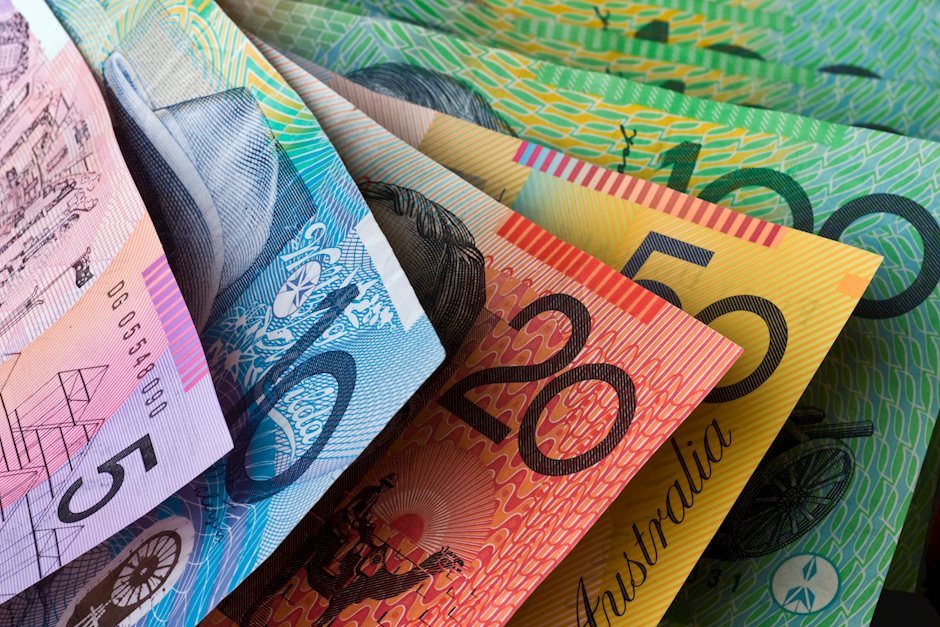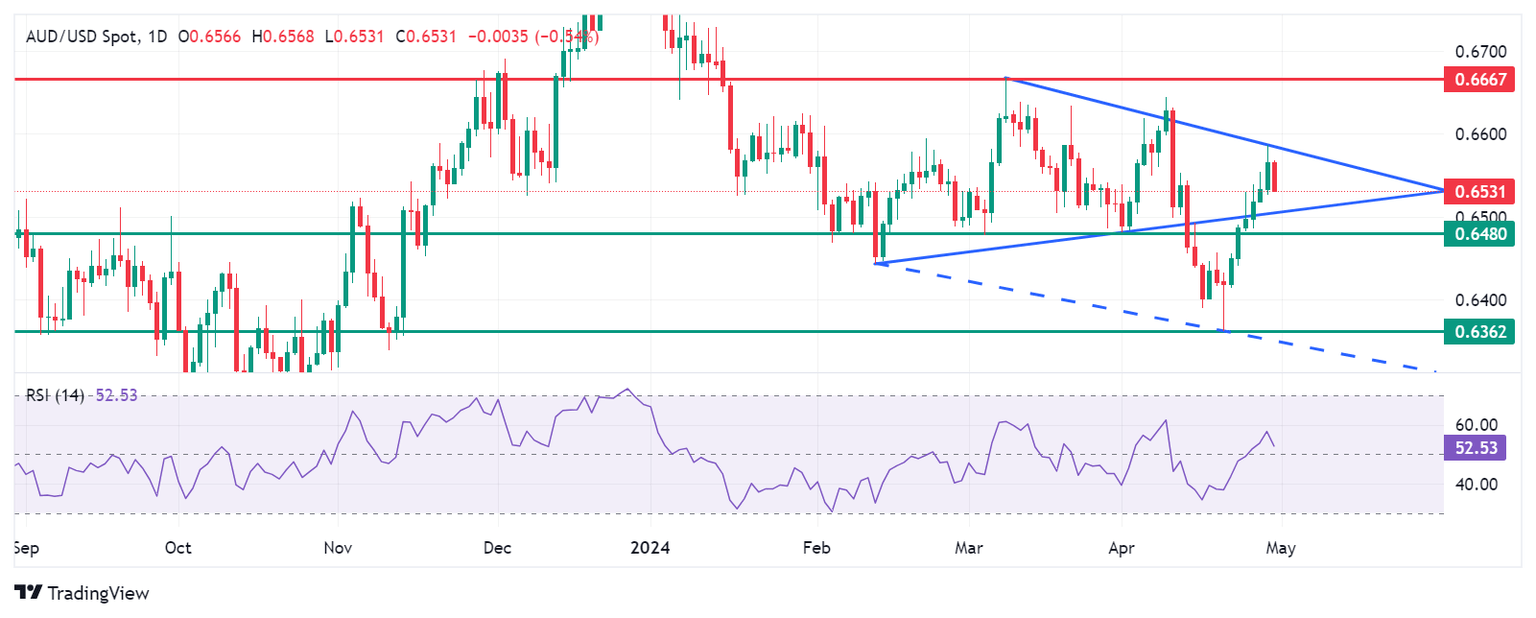Australian Dollar extends downward correction after weaker Retail Sales
- The Australian Dollar has weakened following the release of softer Retail Sales data on Tuesday.
- The Australian Dollar could regain ground due to growing expectations of the RBA delaying interest rate cuts.
- The US Dollar has rebounded, possibly from hawkish comments made by Fed officials, signaling no immediate necessity for rate cuts.

The Australian Dollar (AUD) depreciates following Tuesday's release of lower than expected domestic Retail Sales data. Retail Sales are a key leading indicator directly correlated with inflation and growth prospects, potentially influencing the Reserve Bank of Australia's (RBA) hawkish stance on interest rate trajectory.
The Australian Dollar could potentially regain its footing, buoyed by higher-than-expected domestic inflation data released last week, which has raised expectations that the RBA may delay interest rate cuts. Furthermore, Commonwealth Bank, Australia's largest mortgage lender, has revised its forecast for the timing of the first interest rate cut by the RBA, now projecting only one cut in November, as reported by the Financial Review.
The US Dollar Index (DXY), which gauges the performance of the US Dollar (USD) against six major currencies, has rebounded following hawkish remarks from US Federal Reserve (Fed) officials, indicating no immediate need for rate cuts.
Traders are anticipated to await Wednesday's release of the ADP Employment Change and ISM Manufacturing PMI from the United States (US), alongside the Fed Interest Rate Decision. These events are likely to influence market sentiment and USD movement.
Daily Digest Market Movers: Australian Dollar depreciates after lower Retail Sales
- The seasonally adjusted Australian Retail Sales experienced a 0.4% month-on-month decrease in March, falling short of expectations for a 0.2% increase. This decline contrasts with the previous month's growth of 0.3%.
- In April, China's NBS Manufacturing Purchasing Managers Index (PMI) declined to 50.4, down from the previous reading of 50.8. However, it was higher than the expected reading of 50.3. Additionally, the Non-manufacturing PMI decreased to 51.2, in line with expectations, compared to the previous reading of 53.0 in March.
- The International Monetary Fund (IMF) stated in its latest report, released on Tuesday that China's economic growth is anticipated to decelerate in the coming years. The projected growth rates are 5.2% in 2023, 4.6% in 2024, and 4.1% in 2025. This forecast has implications for the Australian market, as Australia is the largest exporter of commodities and raw materials to China.
- Australian shares kicked off Tuesday with little change as investors paused ahead of the upcoming US Federal Reserve rates decision on Wednesday. Among the 11 sectors, only materials showed gains, while the rest remained relatively unchanged.
- According to the CME FedWatch Tool, the probability of the Federal Reserve keeping interest rates unchanged in the June meeting has increased to 88.4%, up from 83.5% in the past week. The Fed's narrative of higher rates for a longer period strengthens the US Dollar and presents a challenge for the AUD/USD pair.
- The Economic Times reported on Monday that Fed Chair Jerome Powell mentioned it would likely take "longer than expected" to gain confidence that inflation is progressing towards the central bank's 2% target. Powell added that the central bank can maintain rates at a high level "as long as needed." Fed Governor Michelle Bowman expressed her view of "upside risks" to inflation. Meanwhile, Minneapolis Fed President Neel Kashkari raised the possibility of no rate cuts occurring this year.
Technical Analysis: Australian Dollar moves below 0.6550
The Australian Dollar trades around 0.6530 on Tuesday. The pair remains within the symmetrical triangle, with the 14-day Relative Strength Index (RSI) positioned above the 50-level, affirming a bullish recovery stance.
In terms of potential upward targets, the AUD/USD pair may test the triangle’s upper boundary around the level of 0.6585, followed by the psychological barrier at 0.6600, and subsequently aim for March’s high of 0.6667.
On the downside, the AUD/USD pair could test the lower boundary of the symmetrical triangle, aligned with the major support of 0.6500. A break below the major support of 0.6480 could lead the pair to reach April’s low of 0.6362.
AUD/USD: Daily Chart
Australian Dollar price today
The table below shows the percentage change of the Australian Dollar (AUD) against listed major currencies today. The Australian Dollar was the weakest against the US Dollar.
| USD | EUR | GBP | CAD | AUD | JPY | NZD | CHF | |
| USD | 0.13% | 0.22% | 0.22% | 0.65% | 0.37% | 0.59% | 0.20% | |
| EUR | -0.13% | 0.09% | 0.08% | 0.52% | 0.30% | 0.46% | 0.07% | |
| GBP | -0.22% | -0.09% | -0.01% | 0.43% | 0.15% | 0.36% | -0.03% | |
| CAD | -0.21% | -0.09% | 0.01% | 0.42% | 0.15% | 0.37% | -0.02% | |
| AUD | -0.66% | -0.52% | -0.42% | -0.43% | -0.28% | -0.07% | -0.45% | |
| JPY | -0.37% | -0.23% | -0.15% | -0.16% | 0.28% | 0.21% | -0.20% | |
| NZD | -0.57% | -0.46% | -0.36% | -0.37% | 0.07% | -0.21% | -0.39% | |
| CHF | -0.17% | -0.07% | 0.03% | 0.02% | 0.46% | 0.21% | 0.39% |
The heat map shows percentage changes of major currencies against each other. The base currency is picked from the left column, while the quote currency is picked from the top row. For example, if you pick the Euro from the left column and move along the horizontal line to the Japanese Yen, the percentage change displayed in the box will represent EUR (base)/JPY (quote).
Australian Dollar FAQs
One of the most significant factors for the Australian Dollar (AUD) is the level of interest rates set by the Reserve Bank of Australia (RBA). Because Australia is a resource-rich country another key driver is the price of its biggest export, Iron Ore. The health of the Chinese economy, its largest trading partner, is a factor, as well as inflation in Australia, its growth rate and Trade Balance. Market sentiment – whether investors are taking on more risky assets (risk-on) or seeking safe-havens (risk-off) – is also a factor, with risk-on positive for AUD.
The Reserve Bank of Australia (RBA) influences the Australian Dollar (AUD) by setting the level of interest rates that Australian banks can lend to each other. This influences the level of interest rates in the economy as a whole. The main goal of the RBA is to maintain a stable inflation rate of 2-3% by adjusting interest rates up or down. Relatively high interest rates compared to other major central banks support the AUD, and the opposite for relatively low. The RBA can also use quantitative easing and tightening to influence credit conditions, with the former AUD-negative and the latter AUD-positive.
China is Australia’s largest trading partner so the health of the Chinese economy is a major influence on the value of the Australian Dollar (AUD). When the Chinese economy is doing well it purchases more raw materials, goods and services from Australia, lifting demand for the AUD, and pushing up its value. The opposite is the case when the Chinese economy is not growing as fast as expected. Positive or negative surprises in Chinese growth data, therefore, often have a direct impact on the Australian Dollar and its pairs.
Iron Ore is Australia’s largest export, accounting for $118 billion a year according to data from 2021, with China as its primary destination. The price of Iron Ore, therefore, can be a driver of the Australian Dollar. Generally, if the price of Iron Ore rises, AUD also goes up, as aggregate demand for the currency increases. The opposite is the case if the price of Iron Ore falls. Higher Iron Ore prices also tend to result in a greater likelihood of a positive Trade Balance for Australia, which is also positive of the AUD.
The Trade Balance, which is the difference between what a country earns from its exports versus what it pays for its imports, is another factor that can influence the value of the Australian Dollar. If Australia produces highly sought after exports, then its currency will gain in value purely from the surplus demand created from foreign buyers seeking to purchase its exports versus what it spends to purchase imports. Therefore, a positive net Trade Balance strengthens the AUD, with the opposite effect if the Trade Balance is negative.
Author

Akhtar Faruqui
FXStreet
Akhtar Faruqui is a Forex Analyst based in New Delhi, India. With a keen eye for market trends and a passion for dissecting complex financial dynamics, he is dedicated to delivering accurate and insightful Forex news and analysis.

















